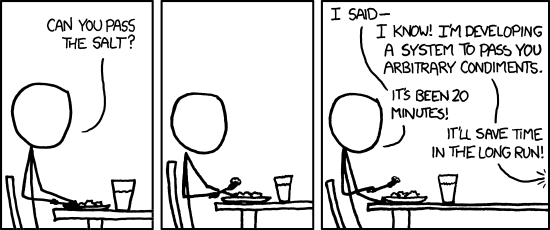The Good Enough Software Design
09 Mar 2014Designing software is a challenge, especially for a perfectionist programmer. There are tons of decisions to make and lots of problems with many solutions. It is very likely that some of them will be hard. You can find yourself searching best practices online, and asking questions at stackoverflow.com. Even if you find practices and you get the answers you want, it is quite possible that you will end up with a design that you are not satisfied with. You doubt whether it is a perfect design or not. Guess what, there is no perfect design!
Mount of Design
It is impossible to solve the design puzzle as a whole. Every requirement will pop up in your brain and you will see the biggest challenges in the design like the choices about the data or the presentation layer. Do I need to use MVC or MVVM? Which ORM tool do I need to use? How am I supposed to handle multiple database connections? Every question will make you feel more overwhelmed and you will start to see the design as an ever growing mountain. Every step you take will seem worthless to the giant mountain in front of you. Feeling overwhelmed can make you want to escape from the problem and the procrastination problem begins. But procrastination won’t lead you to the solution.
The simplest solution to this problem is to Divide & Conquer. You have to stop thinking about the entire system in your head. You should divide the design into smaller blocks and see what you can do to those simple blocks one by one. If possible, choose an iterative development approach like XP. This way you can focus design obstacles iteratively and then you will start to see multiple small hills in your head.
Also don’t spend too much time on choosing tools or APIs to use like a database or a rule engine. These are just tools to make our lives easier. You should spend more time on general design principles like Separation of Concerns. For example SoC will allow you to change any layer or any tool in your software without affecting the others. Apply TDD, it will pump up your courage and let you make radical changes in your software.
Don’t forget; the time spent on design is never enough. As Steve McConnell said in his masterpiece, Code Complete,
When are you done [designing]? Since design is open-ended, the most common answer to that question is “When you’re out of time.”
Requirements Change
Your client or your company has to adapt changes in the business to survive. This means that requirements will change. You can’t write a software to cover all the possible requirements that could come up in the future. There will always be some requirements that didn’t even pop up in your brain. So don’t try to cover future requirements because You Aren’t Gonna Need It. It is like reserving and decorating a room for a baby when you aren’t even expecting one. Try to write a software that covers the current requirements.
Don’t Overengineer
If you work on a specific feature for days that will reduce the work of your client just 5 minutes in a year, then your work is actually useless. I know sometimes we can’t stop ourselves making that particular change, because it might feel us like a better programmer or we might do it just for fun, but you need to consider the cost/benefit ratio. Your time is precious, spend your time on something better.
Simplify
When you just need to store the state of an object into the file system, no time-intensive job or anything special, it is pointless to write a custom object serializer. I saw some designs that look like masterpieces from an engineering point of view, but they made everything overcomplicated. It takes weeks for newcomers to adapt to the system. You shouldn’t make your design overcomplicated. Sometimes the best solution is the simplest one. So keep in mind the KISS principle.
Courage
The design actually is the outcome of the programmer’s experience. It is quite likely that different programmers can come up with different design ideas. This might result in you searching for the best possible way to design a feature since there is no single solution to a design problem. Don’t do that. It doesn’t mean you should stop learning, listening or reading other people’s ideas, of course you should. But design phase is not the time to learn all the best practices in the world that could possibly be applied to your problem. Have some courage, do your best design and start implementing your design ideas.
In the design, you might give a class more responsibility than it should have, or you might not see the inheritance relationship between two classes, or you might miss a clearly visible pattern. When you start coding, you will see some similar flaws in your design. Refactoring is a really good practice to make your design better. Don’t try to make a perfect design, start coding and refactor when your code smells. You will learn from your mistakes and they will be helpful for your future designs.
No Perfect Sofware
Whatever you do you will end up with a piece of software that won’t satisfy you. As Hunt and Thomas wrote in The Pragmatic Programmer;
… perfect software doesn’t exist. No one in the brief history of computing has ever written a piece of perfect software. It’s unlikely that you’ll be the first. And unless you accept this as a fact, you’ll end up wasting time and energy chasing an impossible dream.
I’m sorry, but they are right. Instead of chasing an impossible dream, try to make your design “good enough” and start coding!
